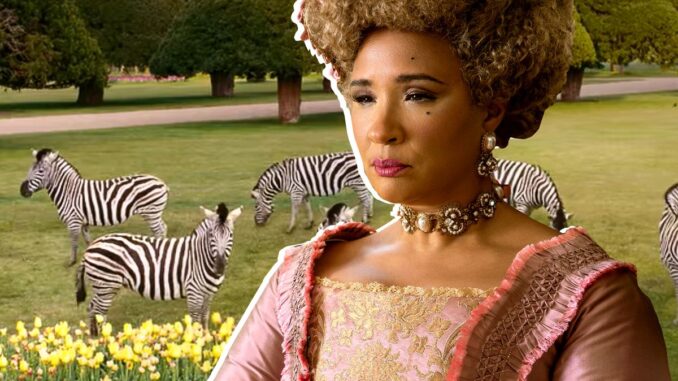
The series’ striped Easter eggs were real, and they were spectacular.
Like season one, the current, second installment of Bridgerton, Netflix’s hit Regency drama created by showrunner Chris Van Dusen and executive produced by Shonda Rhimes, is full of historical Easter eggs that connect the series’ romantic saga with life in 1800s London high society.
This season once again, that’s largely seen through Queen Charlotte (Golda Rosheuvel), one of the notable, real-life figures portrayed on screen. And one of the most surprising plot lines plucked from real life seen comes care of the season’s second episode, “Off to the Races,” when she’s showing off her collection of pet zebras.
“This way. There is much to see,” the Queen tells her guests, Lady Danbury (Adjoa Andoh) as well as sisters Edwina Sharma (Charithra Chandran) and Kate Sharma (Simone Ashley), who have accepted her invitation to visit the palace.
The scene then cuts to the women walking up to the edge of the promenade, where Charlotte points out her new pets, which she refers to with her posh English accent as “zeb-ras.” “Striped horses from Africa, in fact,” she continues, highlighting that after having 15 children of her own, she “can’t think what to name them all.”
Even after Lady Danbury compliments the Queen on her “most spectacular menagerie,” the monarch fails to offer up a single name—including the most famous one used in real life at the time, “The Queen’s Ass,” which refers to the first zebra the actual Charlotte owned.
According to history books, the Queen’s Ass first arrived from South Africa in 1762 as a gift from Sir Thomas Adams, an officer in the Royal Navy. While two were originally sent, only one—the female—survived the trip. The sole zebra was eventually placed at Buckingham Palace, where the Queen had a growing collection of animals, including an elephant and some kangaroos, and exotic fauna.

However, none of them, it seems, were as notorious as the Queen’s Ass, which became the subject of humor, innuendo, and satire at the time. But there was no denying the appeal of the animal, which was largely unseen before it arrived in London. “The Queen’s she-ass … had all her hours employed from morning to night in satisfying the curiosity of the public,” a visitor reported.
It became so famous that reported two Royal Navy warships were named HMS Zebra in the late 18th century while a portrait of the animal was painted by George Stubbs, whose work has been displayed all around the world. (The 1763 painting is now part of the Yale Center for British Art’s collection of the artist’s work.)
When it comes to the zebras’ brief depiction on Bridgerton, Van Dusen tells T&C, it “speaks to her overwhelming fabulousness.”
“To me, Queen Charlotte felt larger than life,” he continued. “She had everything she could ever want in the entire world, yet at the end of the day, there was still something missing. I found that aspect of her character incredibly fascinating to flesh out. Golda Rosheuvel and I had long conversations about that very thing.”
In fact, it’s only one of many details of life seen on the series. While she’s a “creation” of Van Dusen’s for the series, “when I discovered this fascinating historical theory of the real Queen Charlotte being England’s first Queen of color, I knew that she had to be a part of our world in some ways,” he says.
Van Dusen adds, “I started researching her life and found myself really inspired. I wove some of those details into the character’s backstory: Her troubled marriage to King George, for example. Her love for snuff. The menagerie at the palace that she oversaw.” All of which, including her “collections of the most intricate snuff boxes” and those zebras, can be seen throughout the first two seasons of the series.
